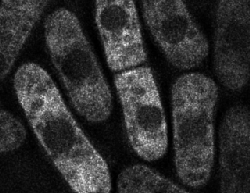Combating fungal diseases

(Medical Xpress) -- Scientists at the Friedrich Miescher Institute for Biomedical Research have discovered a potential new approach for inhibiting the growth of pathogenic fungi. Their findings on the mechanism in question have been published online in the EMBO Journal. Ultimately, immunocompromised patients with fungal infections, in particular, could benefit from this work.
As temperatures soar and more and more people cool off at outdoor pools, the incidence of so called swimmer's ear - an infection of the ear canal - also rises. One of the agents causing this condition is a fungus of the Aspergillus genus. But while swimmer's ear (otomycosis) can be readily treated, other mycoses may be fatal - especially in patients with an impaired immune system. In such cases, it is obviously vital to understand how fungal growth can be inhibited or even arrested.
A group of scientists led by Marc Buhler of the FMI, in collaboration with structural biologists at the ETH Zurich, have now identified a mechanism which, if blocked, should lead to marked inhibition of the growth of pathogenic fungi.
The research project is focusing on a protein known as Dicer. This protein plays a key role in the generation of small RNAs called siRNAs (short interfering RNAs), which are involved in selective suppression of gene expression. As reported in the online edition of the EMBO Journal, the epigeneticists and structural biologists determined the three-dimensional structure of the C-terminal domain of the Dicer protein. In the process, they identified a novel zinc binding motif within an extended fold. When the binding of zinc to fission yeast Dicer was prevented experimentally, it was no longer possible for the protein to become active at the appropriate location in the cell. Rather than being transported to the nucleus, it remained in the cytoplasm. At the same time, the pattern of gene activation was altered and the cells died off.
Interestingly, this motif is also present in a number of fungi which are pathogenic to humans. Commenting on the team's findings, Bühler says: "It's surprising and very encouraging to see how similar this part of the Dicer protein is in the various fungi investigated. So we hope to be able to inhibit growth by blocking zinc binding in those fungi, too. Another reason why this approach appears to be so promising is that this zinc-binding motif is not found in human Dicer. That means that, in a clinical situation, the fungal Dicer could be selectively inhibited without impairing the important functions of Dicer in human cells." This potential therapeutic approach could benefit in particular patients whose immune system is weakened as a result of organ transplantation or cancer, or people with Aids.
More information: Barraud P, Emmerth S, Shimada Y, Hotz HR, Allain FH, Bühler M (2011) An extended dsRBD with a novel zinc-binding motif mediates nuclear retention of fission yeast Dicer, EMBO J. doi:10.1038/emboj.2011.300.

















